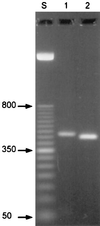Identification of Cryptosporidium felis in a cow by morphologic and molecular methods
- PMID: 10103236
- PMCID: PMC91206
- DOI: 10.1128/AEM.65.4.1455-1458.1999
Identification of Cryptosporidium felis in a cow by morphologic and molecular methods
Abstract
Apicomplexan Cryptosporidium parasites infect a wide range of vertebrate hosts. While some species are limited to a single host group, such as Cryptosporidium baileyi, which infects chickens, other species of this genus, such as C. parvum, infect a wide range of mammalian species from mice to humans. During an investigation of Cryptosporidium infection in cattle on a farm in northern Poland, we identified an infection caused by C. felis, in addition to known infections with C. muris and C. parvum. This new infection was identified based on the size of the oocysts (mean size, 4.3 +/- 0.4 micrometer; range, 3.5 to 5.0 micrometer), as well as by analysis of the molecular sequence of the variable region of the small-subunit rRNA. This finding demonstrates the complex host specificity and circulation in the environment of Cryptosporidium species.
Figures

References
-
- Arai H, Fukuda Y, Hara T, Funakoshi Y, Kaneko S, Yoshida T, Asahi H, Kumada M, Kato K, Koyama T. Prevalence of Cryptosporidium infection among domestic cats in the Tokyo Metropolitan District, Japan. Jpn J Med Sci Biol. 1990;43:7–14. - PubMed
-
- Arrowood M J. Diagnosis. In: Fayer R, editor. Cryptosporidium and cryptosporidiosis. Boca Raton, Fla: CRC Press, Inc.; 1997. pp. 43–64.
-
- Asahi H, Koyama T, Arai H, Funakoshi Y, Yamaura H, Shirasaka R, Okutomi K. Biological nature of Cryptosporidium sp. isolated from a cat. Parasitol Res. 1991;77:237–240. - PubMed
-
- Ash L, Orihel T C. Parasites: a guide to laboratory procedures and identification. 1st ed. Chicago, Ill: American Society of Clinical Pathology Press; 1987. pp. 5–53.
-
- Awad-el-Kariem F M, Warhurst D C, McDonald V. Detection and species identification of Cryptosporidium oocysts using a system based on PCR and endonuclease restriction. Parasitology. 1994;109(Pt 1):19–22. - PubMed
Publication types
MeSH terms
Substances
Associated data
- Actions
LinkOut - more resources
Full Text Sources
Medical

